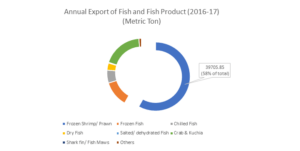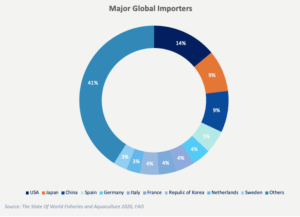
Bangladesh’s agricultural sector contributes 11.63% of GDP, employing around 47% of the working population, with 17 million people (1.4 million women) depending on the fisheries sector. Their livelihoods somehow are related to fishing, farming, fish handling, and processing. The agricultural sector has experienced significant growth over the last couple of decades, with the fisheries sector following suit. According to the data from the Yearbook of Fisheries Statistics (2015-16), the current CAGR for the fisheries sector is about 5.28% over the last 10 years.
Despite shrinking water bodies for fish cultivation, sustained growth has been possible due to the use of better inputs and modern technology contributing to higher yields. Although the country has gained self-sufficiency in terms of agricultural production, the population is growing and will reach 185 million by 2030.
In 2016-17, the inland (closed and open) fisheries and marine fisheries produced 4.13 million metric tons. To further boost production, the government’s ongoing seventh Five-year Plan (2016-2020) aims to increase cultured fish production by 45% from the FY2012-13 baseline of 1.7 million metric tons. This will require more feed, medicine, and equipment to meet the demand. Thanks to advanced production methods and commercial feed, fish production has steadily increased. As capture fisheries production declines and demand for fish protein rises, aquaculture is moving towards intensification.
Export Market
The fisheries industry in Bangladesh has been a significant contributor to the country’s foreign exchange earnings. In fact, the sector experienced its highest export earnings in the last decade in 2013-14, generating BDT 4,776.92 crore through the export of 77.33 thousand MT of fish and fisheries products. This trend continued in 2016-17, with the industry earning BDT 4,287.64 crore from the export of nearly 68.31 thousand MT of fish and fisheries products.

Shrimp is one of the major export items in Bangladesh. Over the past 14 years, shrimp and prawn production, including capture, has increased from 1,60,000 MT to 2,46,000 MT. This growth in exports can be attributed to the industry’s commitment to adhering to HACCP and traceability regulations, as required by the European Union (EU) and the USA. In fact, in 2015, 80% of all shrimp exports were to these two markets. Other important export destinations include Belgium, the UK, the Netherlands, Germany, China, France, the Russian Federation, Japan, and Saudi Arabia.

For more details, please Contact Us.
or, WhatsApp Us: +880 1713222363



